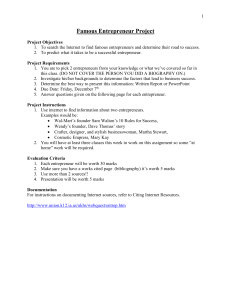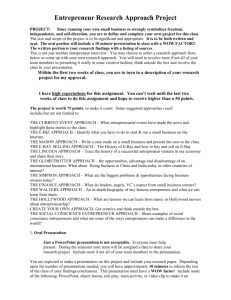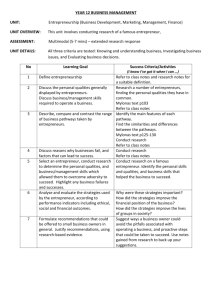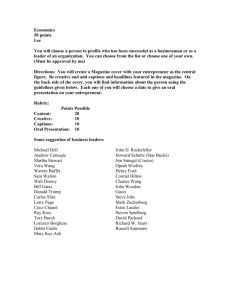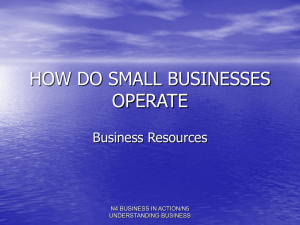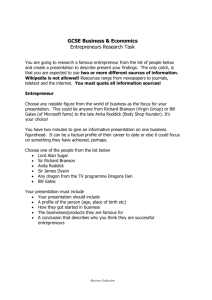Chapter 9
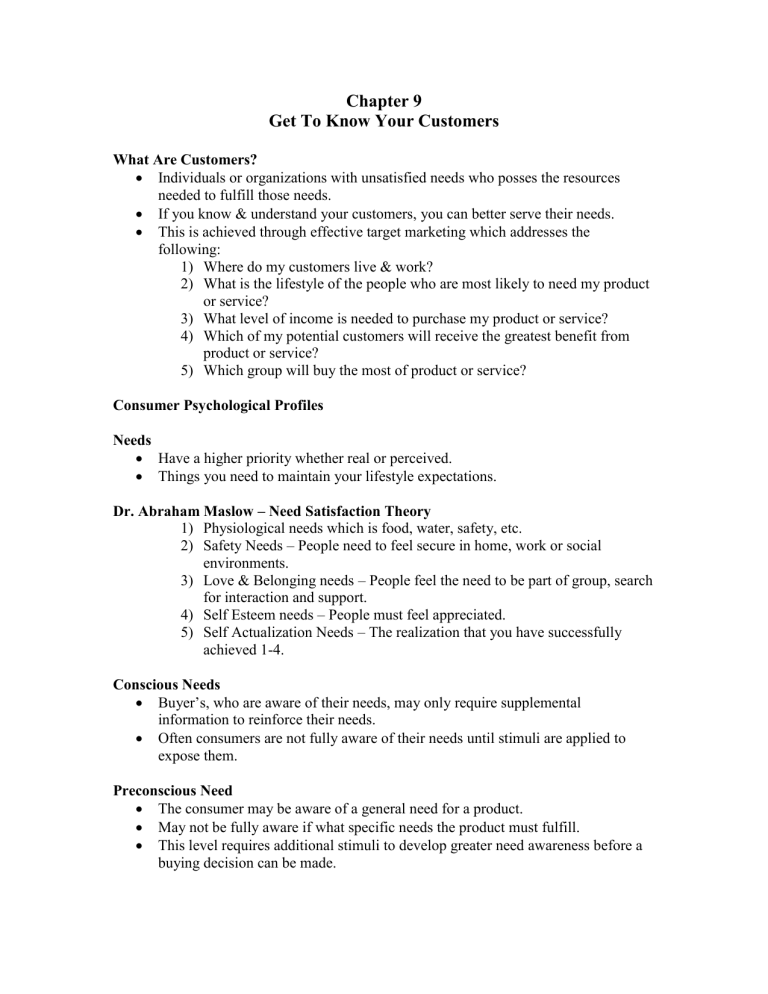
Chapter 9
Get To Know Your Customers
What Are Customers?
Individuals or organizations with unsatisfied needs who posses the resources needed to fulfill those needs.
If you know & understand your customers, you can better serve their needs.
This is achieved through effective target marketing which addresses the following:
1) Where do my customers live & work?
2) What is the lifestyle of the people who are most likely to need my product or service?
3) What level of income is needed to purchase my product or service?
4) Which of my potential customers will receive the greatest benefit from product or service?
5) Which group will buy the most of product or service?
Consumer Psychological Profiles
Needs
Have a higher priority whether real or perceived.
Things you need to maintain your lifestyle expectations.
Dr. Abraham Maslow – Need Satisfaction Theory
1) Physiological needs which is food, water, safety, etc.
2) Safety Needs – People need to feel secure in home, work or social environments.
3) Love & Belonging needs – People feel the need to be part of group, search for interaction and support.
4) Self Esteem needs – People must feel appreciated.
5) Self Actualization Needs – The realization that you have successfully achieved 1-4.
Conscious Needs
Buyer’s, who are aware of their needs, may only require supplemental information to reinforce their needs.
Often consumers are not fully aware of their needs until stimuli are applied to expose them.
Preconscious Need
The consumer may be aware of a general need for a product.
May not be fully aware if what specific needs the product must fulfill.
This level requires additional stimuli to develop greater need awareness before a buying decision can be made.
Unconscious Need
Sometimes people do not know why they buy a particular product or service.
It may be an unsatisfied need exposed years before and suppressed until the purchase opportunity is presented.
Until the purchase opportunity arises at a time when the necessary funds are available, it remains a suppressed, unconscious need.
Perceptions
The way you view and understand things, as determined by your background and mental framework.
These are difficult to interpret and understand.
Successful Entrepreneurs must understand how customers perceive their product and service.
Selective Distortion drives buyers to transpose information that is not in agreement with their perceptions into information that does not agree.
Selective Retention is the customer retaining only information that aligns with their personal beliefs and values. They discard or ignore information that does not.
Motivations
Selfishness – Everyone has the right to satisfy their personal needs.
Greed – The product or service is a bargain.
Hedonism – Pleasure or relief are readily available.
Indolence – Perceived convenience allows ease of acquisition.
Fear – Missing out can cause pain.
Attitudes
Defined by how a person feels about something.
You want customers to feel positive about your product.
Entrepreneurs do it through personal interaction with the customer that builds confidence.
As early as possible, an aspiring entrepreneur should learn as much as possible about how their target market thinks and behaves.
Consumer Personality Styles
One important application is designing a marketing strategy that stimulates your target customer.
Thinker Styles
Great emphasis on logic.
Very deliberate and will ask a lot of questions.
Requires presenting information in a logical and analytical manner.
If this is your target market you must be geared toward information presentation.
Intuitor Style
These people are future orientated.
They are creative, broad minded, idealistic and charismatic.
They are long range conceptual thinkers.
This will require demonstrating the overall concept of the product and the long range benefits.
Feeler Style
They are people orientated and sensitive to others’ needs.
They are not afraid to show their emotional side.
They can be spontaneous and compulsive.
They are rooted in the past more than the future.
You should use a personal marketing approach and appeal to their peopleorientated nature to gain their trust and confidence.
Sensor Style
These people are action orientated.
They are decisive and do not get bogged down in details.
They are down to earth, impatience and seek perfection.
They live in a chaotic environment.
They want immediate satisfaction.
Marketing efforts should be to the point and often start with results.
Self-Concepts
Real Self – How they really are.
SelfImage – How they think other people see them.
Ideal Self – What they would like to be.
Looking Glass Self – How they want others to regard them.
Behavior Patterns of Consumer Groups, Table 9-1, Page 193
Generation Y – The youngest category of shoppers drives the market for hi-tech products. Born after 1982, they love to shop.
Generation X – This is the first generation of dual career households and single parents. Born between 1968 + 1982.
Older Consumers – The current population of seniors is much healthier, wealthier, and better educated than previous generations.
Ethnic Markets – The U.S. marketplace has been greatly influenced by the growth of three minorities, African-Americans, Asian-Americans, and Hispanics.
Consumer Decision Making
Utility Satisfaction
Consumers will choose from products to gain the utmost satisfaction.
The decision making process is not always easy.
Routine Decisions – Do not require scrutiny and research.
Non-Routine Decisions – Infrequent or first purchase and will require a decision making process.
Extensive Decisions – The belief that the decision is extremely important and has a long term impact on personal budgets and lifestyles.
Consumer Decision Making Process, Figure 9-2, Page 195
1) Recognize a need.
2) Analyze the cause of the need.
3) Review alternatives to relieve the need.
4) Select from the desired alternatives.
5) Make the exchange transaction.
6) Evaluate the purchase.
The Black Box Approach Figure 9-3, Page 196
Describes the mystery of what goes on in the buyer’s mind.
Stimulus through the product presentation.
Black Box is the mental internalization of the presentation.
Response is the behavior of the buyer.
The Informed Consumer
The greater the uncertainty, the more effort is required in the decision making process.
Consumer have never been smarter than today.
Consumers have never been more educated than today.
Brand loyalty is not the strict basis it once was.
This is an advantage to the entrepreneur. You can compete with major brands because of the tools to inform and research the consumer.
This process creates trust.
The Satisfied Customer
Satisfied Customers return. (Ex. Car Wash scenario, page 198)
It is less expensive and more profitable to sell to existing customers than to sell to new customers.
A good entrepreneur will make every effort to have his/her customers return.
For customers, it is worth an added cost to do business with a company that can react quickly to their needs.
It is essential that the customers have a high regard and positive image of the business owner they are patronizing.
Customer Relations
The best policy is one that treats all customers equally.
Small customers should be treated just like large customers.
Services can be offered without necessarily driving up costs.
Good customer relation’s means repeat business.
The customer comes to the business with a need to fulfill. It is the responsibility of the business to do it’s very best to fill that need.
Relationship Marketing
Knowing your customer is a strategic advantage/building relationship is a vital ingredient to the success of small business.
You will receive more volume with fewer transactions.
Spend less money on attracting new customers, which is more costly than selling to established customers.
Concentrate on continuous improvement.
Get more involved with customers by providing education and building future sales.
Be seen as credible, sincere, and trustworthy.
Receive strong referrals from a satisfied customer base.
Social Responsibility
Good customer relations equate with strong goodwill.
The Entrepreneur has the responsibility to give something back to the community from which the business derives success.
Over time the business gains customer through respect of your efforts.
Homework
The Global Entrepreneur Page 196
Ethics for Entrepreneurs Page 200
Ship in a Bottle
Read Chapter 10
Page 202

